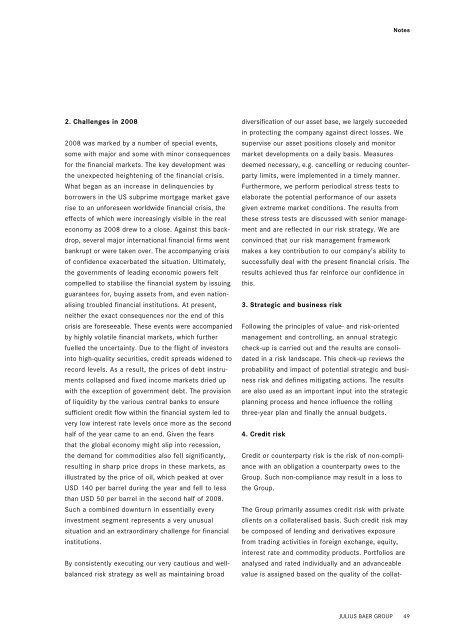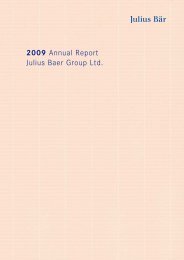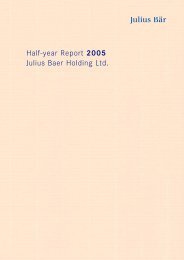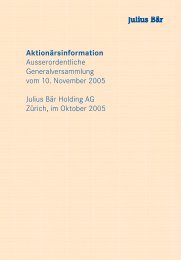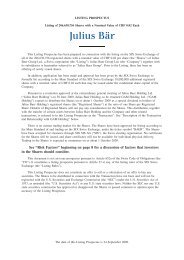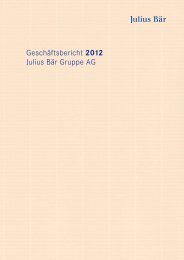2008 Annual Report Julius Baer Holding Ltd. - Julius Bär Gruppe
2008 Annual Report Julius Baer Holding Ltd. - Julius Bär Gruppe
2008 Annual Report Julius Baer Holding Ltd. - Julius Bär Gruppe
You also want an ePaper? Increase the reach of your titles
YUMPU automatically turns print PDFs into web optimized ePapers that Google loves.
2. Challenges in <strong>2008</strong><br />
<strong>2008</strong> was marked by a number of special events,<br />
some with major and some with minor consequences<br />
for the financial markets. The key development was<br />
the unexpected heightening of the financial crisis.<br />
What began as an increase in delinquencies by<br />
borrowers in the US subprime mortgage market gave<br />
rise to an unforeseen worldwide financial crisis, the<br />
effects of which were increasingly visible in the real<br />
economy as <strong>2008</strong> drew to a close. Against this backdrop,<br />
several major international financial firms went<br />
bankrupt or were taken over. The accompanying crisis<br />
of confidence exacerbated the situation. Ultimately,<br />
the governments of leading economic powers felt<br />
compelled to stabilise the financial system by issuing<br />
guarantees for, buying assets from, and even nationalising<br />
troubled financial institutions. At present,<br />
neither the exact consequences nor the end of this<br />
crisis are foreseeable. These events were accompanied<br />
by highly volatile financial markets, which further<br />
fuelled the uncertainty. Due to the flight of investors<br />
into high-quality securities, credit spreads widened to<br />
record levels. As a result, the prices of debt instruments<br />
collapsed and fixed income markets dried up<br />
with the exception of government debt. The provision<br />
of liquidity by the various central banks to ensure<br />
sufficient credit flow within the financial system led to<br />
very low interest rate levels once more as the second<br />
half of the year came to an end. Given the fears<br />
that the global economy might slip into recession,<br />
the demand for commodities also fell significantly,<br />
resulting in sharp price drops in these markets, as<br />
illustrated by the price of oil, which peaked at over<br />
USD 140 per barrel during the year and fell to less<br />
than USD 50 per barrel in the second half of <strong>2008</strong>.<br />
Such a combined downturn in essentially every<br />
investment segment represents a very unusual<br />
situation and an extraordinary challenge for financial<br />
institutions.<br />
By consistently executing our very cautious and wellbalanced<br />
risk strategy as well as maintaining broad<br />
diversification of our asset base, we largely succeeded<br />
in protecting the company against direct losses. We<br />
supervise our asset positions closely and monitor<br />
market developments on a daily basis. Measures<br />
deemed necessary, e.g. cancelling or reducing counterparty<br />
limits, were implemented in a timely manner.<br />
Furthermore, we perform periodical stress tests to<br />
elaborate the potential performance of our assets<br />
given extreme market conditions. The results from<br />
these stress tests are discussed with senior management<br />
and are reflected in our risk strategy. We are<br />
convinced that our risk management framework<br />
makes a key contribution to our company’s ability to<br />
successfully deal with the present financial crisis. The<br />
results achieved thus far reinforce our confidence in<br />
this.<br />
3. Strategic and business risk<br />
Following the principles of value- and risk-oriented<br />
management and controlling, an annual strategic<br />
check-up is carried out and the results are consolidated<br />
in a risk landscape. This check-up reviews the<br />
probability and impact of potential strategic and business<br />
risk and defines mitigating actions. The results<br />
are also used as an important input into the strategic<br />
planning process and hence influence the rolling<br />
three-year plan and finally the annual budgets.<br />
4. Credit risk<br />
Notes<br />
Credit or counterparty risk is the risk of non-compliance<br />
with an obligation a counterparty owes to the<br />
Group. Such non-compliance may result in a loss to<br />
the Group.<br />
The Group primarily assumes credit risk with private<br />
clients on a collateralised basis. Such credit risk may<br />
be composed of lending and derivatives exposure<br />
from trading activities in foreign exchange, equity,<br />
interest rate and commodity products. Portfolios are<br />
analysed and rated individually and an advanceable<br />
value is assigned based on the quality of the collat-<br />
JULIUS BAER GROUP 49


